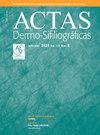摘要
简介杜匹鲁单抗是一种IL-4/IL-13抑制剂单克隆抗体,已被批准用于治疗中重度特应性皮炎(AD),具有显著的安全性和有效性。本研究的目的是评估使用杜匹单抗期间血液嗜酸性粒细胞和其他实验室指标的变化:从2018年到2022年,我们开展了一项多中心、前瞻性、观察性研究,研究对象是接受杜必鲁单抗治疗的中重度特应性皮炎青少年和成人患者,他们分别来自西班牙圣女大学医院(Hospital Universitario Virgen de las Nieves)和葡萄牙科英布拉大学医院(Coimbra University Hospital)。我们在基线和第 8、16、24 和 48 周收集了皮炎临床评分、全血细胞计数、血清总 IgE 和 LDH 水平:我们共纳入了 81 名患者(41 名女性/40 名男性;平均年龄为 30.86 ± 12.26 岁)。各中心的临床和人口统计学特征相似。AD严重程度量表(EASI、SCORAD、ItchVAS和SleepVAS)显示,从治疗的第8周开始,AD症状持续改善。嗜酸性粒细胞水平在第16周(0.69 x103/μL)明显高于基线(0.41 x103/μL)(p = 0.018),并在第48周恢复到基线水平(0.59 x103/μL,p > 0.05)。LDH和IgE水平在研究期间有所下降:我们的研究表明,AD 的临床症状明显改善,但嗜酸性粒细胞水平在第 16 周出现了轻度和自限性升高,且与任何临床症状无关。因此,服用杜必鲁单抗的 AD 患者血清嗜酸性粒细胞水平升高似乎与临床无关,不应作为停药的条件。Introduction: Dupilumab is an IL-4/IL-13 inhibitor monoclonal antibody approved for the treatment of moderate-to-severe atopic dermatitis (AD) with remarkable safety and efficacy profiles. However, former studies have reported an increase in serum eosinophils during treatment, with undetermined clinical significance. The objective of this study is to evaluate changes in blood eosinophils and other laboratory parameters while on dupilumab.
Methods: We conducted a multicenter, prospective, observational study from 2018 to 2022 with adolescent and adult patients with moderate-to-severe atopic dermatitis treated with dupilumab from Hospital Universitario Virgen de las Nieves, Spain, and Coimbra University Hospital, Portugal. Clinical scoring of the dermatitis, complete blood count, total serum IgE and LDH levels were collected at baseline and on weeks 8, 16, 24 and 48.
Results: We included a total of 81 patients (41 women/40 men; mean age of 30.86±12.26 years). Clinical and demographic characteristics were similar across centres. AD severity scales (EASI, SCORAD, BSAM, ItchVAS and SleepVAS) showed sustained improvement from week 8 of treatment onwards. Eosinophil levels were significantly higher on week 16 (0.69×103/μL) vs baseline (0.41×103/μL) (p=0.018) and returned to baseline levels on week 48 (0.59×103/μL, p>0.05). LDH and IgE levels decreased during the study.
Conclusion: Our study showed a significant clinical improvement of AD but a mild and self-limited increase in eosinophil levels on week 16, not associated with any clinical signs. Therefore, elevated serum eosinophil levels in AD patients on dupilumab does not seem clinically relevant and should not condition treatment withdrawal.

 求助内容:
求助内容: 应助结果提醒方式:
应助结果提醒方式:


